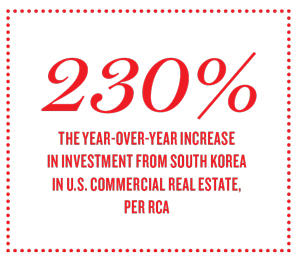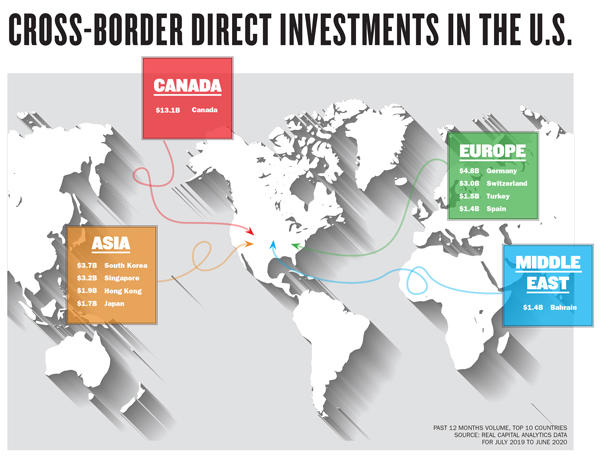
In April, as New York faced the darkest days of the coronavirus outbreak to date, the city’s biggest office landlord decided it needed a $1 billion cash cushion.
SL Green Realty’s planned sale of the Daily News Building for $815 million had fallen through weeks prior, and the real estate investment trust sought to recapitalize other assets to shore up its balance sheet for the uncertain times ahead.
That’s when an old partner stepped in to lend a helping hand from overseas, providing nearly half of the liquidity the public company was looking for. The South Korean National Pension Service joined Hines in purchasing a 49.5 percent stake in One Madison Avenue, SL Green’s 1.4 million-square-foot office development next to Madison Square Park, for $492 million.
It marked one of the largest investment sales deals in the U.S. in the second quarter. It also came a few years after South Korea’s pension fund poured $500 million into one of SL Green’s other marquee projects — the 1.6 million-square-foot office tower One Vanderbilt, which opened this month.
With more than $600 billion in assets under management, the National Pension Service is the world’s third-largest pension fund and one of the pioneers of a massive wave of Korean investment in global real estate over the past cycle as other funds, insurance firms, banks and credit unions are getting in on the action.
“They realized that global alternative investment is a great way to have consistent returns that are relatively higher than stocks and bonds, so they added that to the playbook,” said Willow River Capital Management founder Thomas Yoo, who has helped two Korean asset management firms launch their New York offices over the past seven years.
While the buying sprees of Chinese conglomerates may have dominated headlines in the mid-2010s, rising investment from South Korea has helped fill the gap in recent years, after strict capital controls and the ongoing trade war shut down outflows from its larger Asian neighbor.
Asia’s fourth-largest economy was the third leading source of cross-border equity investment in U.S. commercial real estate — just behind perennial front-runners Canada and Germany and just ahead of Singapore — between July 2019 and June 2020, according to Real Capital Analytics.
Overall, foreign investment in U.S. commercial real estate totaled $42.8 billion in the 12-month period RCA analyzed, down 46 percent year-over-year. The bulk of that drop was driven by a decline in Canadian investment, following Brookfield Asset Management’s big company-level acquisitions the year prior, the data shows.
But the $3.6 billion in Korean investment in major U.S. cities, including New York, Dallas and Los Angeles, fueled a year-over-year increase of about 230 percent for the country. At the same time, Canadian investment dropped 70 percent to a still-massive $13 billion, while German acquisitions fell by 23 percent to $4.8 billion in that 12-month period.
“South Korean players have been stalwart global investors for several years,” Tom Leahy, RCA’s senior director of EMEA (Europe, the Middle East and Africa) analytics, wrote in a report on the country’s record-breaking 2019.
While the country’s public funds and large institutions paved the way in the early 2010s, Leahy said, “the investor base has since broadened markedly, reflecting the depth of capital in South Korea … and the drive to diversify.”
In the first three quarters of 2019, Korean investors spent $11.5 billion on commercial real estate outside Asia — more than their peers in China, Hong Kong and Singapore combined, according to the report. The bulk of that investment was directed toward Europe rather than the U.S., due to the high cost of hedging against currency risk.
 But things started to change last year, as the Federal Reserve began a series of rate cuts that helped bring down those costs, and Korean investors quickly began looking for deals in America once more. As 2020 kicked off, many expected it to be a banner year for South Korean investment in U.S. real estate, Yoo said.
But things started to change last year, as the Federal Reserve began a series of rate cuts that helped bring down those costs, and Korean investors quickly began looking for deals in America once more. As 2020 kicked off, many expected it to be a banner year for South Korean investment in U.S. real estate, Yoo said.
“This was supposed to be the year of investing in the U.S. — and then the pandemic hit,” he said. “The good news is that just recently [Korean investors are] starting to come back. They’re saying, ‘Enough is enough, we need to do deals.’”
Taking stock
South Korean investments in U.S. commercial real estate had already gained momentum in the months leading up to the Covid crisis, and the One Madison deal helped solidify that after the pandemic and economic fallout began.
For SL Green and other major property owners looking for equity partners in hard times, there’s an added dose of goodwill.
“The National Pension Service of Korea is excited to join SL Green in another marquee project that will strengthen our already proven partnership,” Scott Kim, the pension fund’s head of real estate investment, said in a statement in May after the deal closed.
SL Green did not respond to requests for comment.
While the One Madison deal set a new record for South Korea in the 12-month period RCA analyzed, the second largest Korean acquisition since July 2019 was 195 Broadway, an office building in Lower Manhattan. Korea Investment & Securities and Samsung SRA Asset Management joined New York-based L&L Holding Company to buy a 95 percent stake in the tower from JPMorgan Asset Management for $475 million.
The securities firm and Samsung’s real estate investment vehicle then moved to source equity from additional investors back home, a common practice with outbound real estate investment from South Korea. Samsung planned to collect about $50 million from financial institutions, while KIS set up a $200 million retail fund for mom-and-pop investors, the Korea Economic Daily reported last year.
At the same time, South Korea’s appetite for U.S. real estate extends beyond New York.
In September 2019, a group of companies including Hana Financial Investment and KDB Life Insurance paid about $100 million for a majority stake in AT&T’s global headquarters in Dallas.
The Texas metropolis saw another big Korean deal in February as KB Asset Management paid about $370 million for the office and retail components of the Union, a 866,000-square-foot mixed-use complex completed in 2018.
Meanwhile, KIS and Tiger Alternative Investors went on a student housing buying spree in California, Michigan, Texas and Florida, investing more than $700 million alongside other U.S.-based partners, according to RCA.
Korean conglomerate Aju Group also expanded its U.S. footprint in late 2019, acquiring two Manhattan hotels and the Ace Hotel in downtown Los Angeles for a total of $250 million.
But the most prominent Korean acquisition of all was one that failed to close.
Last September, Mirae Asset Management emerged as the winning bidder for a $5.8 billion hotel portfolio owned by China’s embattled Anbang Insurance Group. In May, however, Mirae moved to terminate the deai.
While Anbang argues that Mirae simply got cold feet because of the pandemic, Mirae has pointed to a convoluted deed fraud scheme. The tangle of alleged claims to ownership of the hotels has mystified court officers as well.
“Those folks have vanished into the ether,” Travis Laster, vice chancellor on the Delaware Court of Chancery, said in May. “It may be because they never existed in the first place. It may be because they are fraudsters. It may be because they are somewhere in China.”
A new normal
However Mirae’s dispute with Anbang plays out, big hotel sales face major headwinds as the pandemic continues.
But there are still deals to be made in other sectors.
With historic levels of dry powder waiting to be deployed, investors around the world have been trying to figure out how to make deals work in the age of social distancing and quarantines.
“There’s a unique feature to this crisis in that, even for domestic investors, there have been new challenges associated with evaluating investment opportunities [on the ground],” said Sam Chandan, dean of NYU’s Schack Institute of Real Estate.
“Even more so with investors from abroad, because of travel restrictions,” he added.
While some of the larger asset managers in South Korea will have boots on the ground in the U.S., the syndicated nature of most Korean deals adds another wrinkle to the process.
As part of the usual protocol, end investors in Korea also have to make site visits before their investment committees can sign off on deals, Yoo said.
“There’s been a focus on getting creative and entrepreneurial about how to get something done,” said Maggie Coleman, JLL’s head of international capital for the Americas. “The South Korean investors we work with, across the spectrum, have remained active in reviewing deals throughout this timeframe.”
Sources mentioned a wide range of ways investors have handled due diligence in recent months.
Virtual tours have become more common, and some investors have delegated site visits to local partners or brokerages. Some have had New York-based employees drive long distances to examine a site, and others have simply included two-week quarantines in their travel plans.
And in some cases, investors have made arrangements with securities companies where the closing of a deal is contingent on a site tour at a later date.
“The idea is that within a year, hopefully, they’ll be able to come in, and if they find something in their due diligence or there are legal issues, they have the right to sell back to the securities company,” said Kwon Lee, a partner at Mayer Brown’s New York office and co-head of the law firm’s U.S. Asia Real Estate practice.
“That’s been a recent innovation, to make sure end investors feel comfortable,” he added.
A European tour
When investing in commercial properties in the States, foreign buyers will often seek to hedge their exposure to currency fluctuations by buying financial instruments that can offset the impact of adverse changes in exchange rates.
Given the way that currency swaps work, higher interest rates tend to make hedging more expensive. This has been a major concern for Korean institutional investors, who are by and large required to hedge currency risk on their equity investments due to the country’s regulatory environment.
“The cost of hedging prior to Covid stood at over 200 basis points,” said Alex Foshay, head of Newmark Knight Frank’s international capital markets division. That made South Korea “extremely uncompetitive in the U.S. market,” he noted.
“So they were directing all of their investment to the European Union, which has seen unprecedented levels of Korean investment in the past two years,” Foshay added.

The Korean buying binge in Europe began in London, with massive deals like the National Pension Service’s $1.5 billion acquisition of Goldman Sachs’ new headquarters in the British capital. As Brexit worries grew and competition heated up, Korean firms moved to the continent in search of new opportunities, scooping up major properties in France, Belgium, Germany, Slovakia, Poland and elsewhere.
But by late last year, this wave of demand had started to make it difficult to find good investment opportunities.
“The market [in Europe] got very tight and the pricing got aggressive,” Yoo said. “The securities firms started getting stuck, and they couldn’t sell down the equity because the institutions didn’t want it anymore.”
Just as the European market appeared to be near saturation, the Federal Reserve began cutting its benchmark rate, opening up a range of investment opportunities that had been largely closed off for the past several years.
Further rate cuts in the wake of the pandemic mean that hedging costs for U.S. investment will likely stay low for years to come.
Securities blanket
Since regulatory reforms loosened capital requirements for securities firms in South Korea in 2014, these companies have played a major role in facilitating overseas real estate investment.
A typical real estate acquisition involves a two-step process for these companies. First, a licensed asset manager sets up a tax-efficient, single-purpose trust for a deal and issues beneficiary certificates.
Securities firms then buy up these certificates and sell them to numerous end investors.
“This expedites the process because, when you have four or five investors that all have to go through their own committee process, it takes a long time,” Lee said.
“So rather than doing that, one or two major securities firms come in to close the deal, and then they sell down the interest,” Lee said.
Another driver of outbound investment from Korea has been the saturation of the real estate markets at home.
“The country is relatively small, so the domestic market is small compared to all the capital they have to deploy,” Yoo said.
Core concentrations
Even as prohibitive hedging costs had blocked Korean institutions from making equity plays in U.S. real estate, the country had emerged as a dominant source of foreign debt investment.
Last year, investors in South Korea accounted for 17 percent of cross-border investment in U.S. commercial real estate on the debt side, more than any other country, according to Preqin.
So far in 2020, that percentage has risen to 28, about as much as the next three countries — Canada, Japan and China — combined.
Due to favorable tax treatment and higher returns on investment, Korean lenders carved out a niche in the mezzanine lending space in particular. But much of that lending was concentrated on hotels, an asset class that is now under serious pressure due to the pandemic.
“Hospitality was the plurality of the types of debt deals we were seeing, from a few years ago all the way up to just before the pandemic,” said Dave Stewart, another partner in the real estate practice of Mayer Brown’s New York office.
Most investors Stewart works with have yet to take losses on these positions, he said, as many have worked out temporary arrangements with their lenders to postpone debt obligations.
“It was an extended bull run, and now they’re seeing what can happen when the markets go bad,” Yoo said, adding that he expects Korean investors to remain active in major U.S. real estate markets post-coronavirus.
Although foreign appetites for U.S. commercial properties are still strong, the pandemic has narrowed the range of options that overseas buyers are considering.
“Market uncertainty is driving them to a very narrow definition of ‘core’ — lease terms of over 10 years, highly credit-worthy tenancies, relatively modern assets in good locations,” Foshay of Newmark Knight Frank said.
He added that investors from South Korea are most aggressive in this “core sector” with German funds, which had also faced hedging cost headwinds, coming in close behind. In the months since coronavirus began, Korean firms have acquired logistics facilities in Germany, Poland and Scotland and have been seeking similar opportunities in the U.S. as well.
A partnership between the New York real estate investment trust VEREIT and KIS acquired a 2.3 million-square-foot distribution and warehouse facility in Dallas for $250 million last month, for example. And Foshay noted that Mirae and Hana are closing in on big hundred-million-dollar deals for Amazon-leased facilities in the States.
“We sort of hit a reset button with Covid, and the economic cycle,” Foshay said, adding that he expects to see “a prolonged run” of investment from South Korean and other Asian-Pacific countries as hedging costs remain low.
Trade tensions
One big difference from the previous cycle, however, will likely be a lack of overseas investment from China, largely due to the country’s capital controls. The U.S. government’s recent moves against TikTok and WeChat haven’t helped, as Trump’s ongoing trade war raises new concerns for a wide range of Chinese companies seeking to do business in the States.
For the time being, that means major sources of cross-border investment into U.S. real estate will come from countries where geopolitics are much less contentious.
“These are friendly nations that are allies, and there’s a nice tax treaty between the two countries,” Yoo said in reference to the relationship between South Korea and the U.S. “It’s a very interdependent type of relationship.”
That said, the Trump administration has also put relations with Canada, Germany and South Korea into question on more than one occasion — over issues including tariffs and the costs of hosting U.S. military bases.
“Changes in almost any bilateral relationship are something that investors around the world are considering,” Chandan said. “Even with Canada, there have been disruptions in trade flows.”
But to the extent that the worldwide geopolitical situation remains uncertain, sources say that could bolster America’s status as a safe haven for foreign investment. That’s largely due to the country’s relatively open business markets and its unique position in the world economy with the U.S. dollar serving as the world’s de facto reserve currency.
“Overall, the U.S. market is still a source of transparency and capital preservation,” JLL’s Coleman said. “And as institutional groups are focusing on diversification outside of their region, it will be a recipient of capital.”
